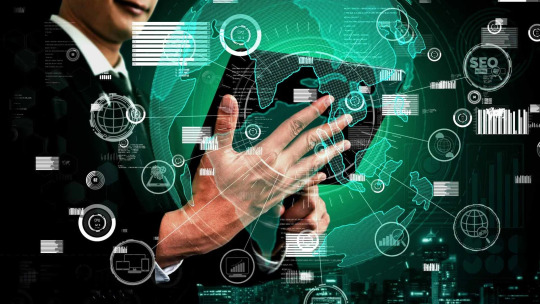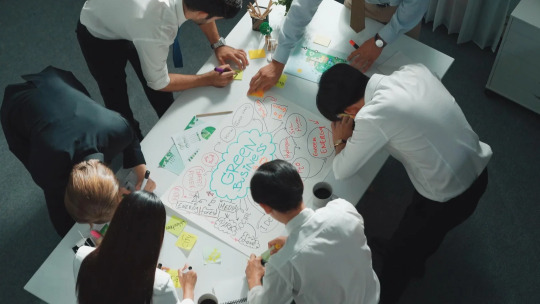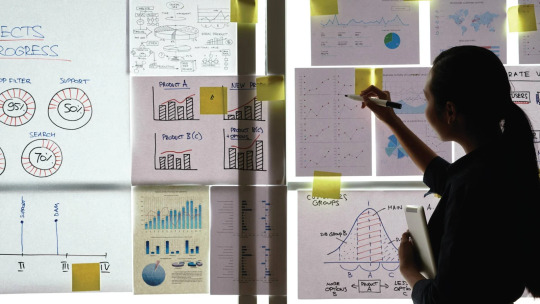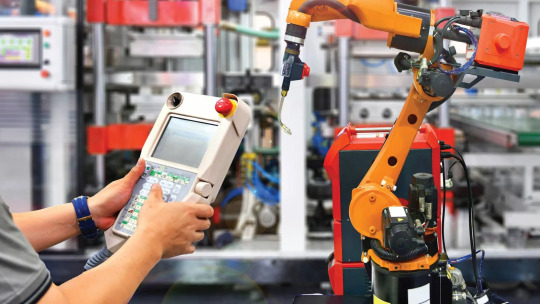Text
Culture Shift with Digital Transformation 2025 Strategic Clarity
Organizations across industries are accelerating their digital transformation initiatives at unprecedented speed. This rapid pace, often called tech at warp speed, demands more than new technology investments—it requires precise strategic clarity from leadership teams. As 2025 approaches, companies that fail to align innovation with clear priorities risk wasting budgets, losing talent, and missing out on the true potential of digital change.

Understanding Tech at Warp Speed
The race for digital relevance has intensified. Emerging technologies like AI, 5G, automation, and cloud infrastructure are transforming how companies compete. However, simply adopting new tools is not enough. Organizations must understand that tech at warp speed means faster cycles of change, shorter product lifespans, and evolving customer expectations. Keeping up requires a mindset that embraces agility while avoiding the chaos that comes from poorly defined roadmaps.
The Need for Strategic Clarity in 2025
In 2025, businesses will face more complexity than ever. Strategic clarity is the compass that keeps teams aligned when navigating rapid transformation. Leaders must break silos and ensure that digital strategies connect directly to measurable business value. This means linking tech investments to clear KPIs, redefining how teams collaborate, and ensuring that change management supports people as much as technology. The companies that do this will lead their sectors through resilience and innovation.
How to Align Digital Transformation with Business Goals
Success lies in embedding digital transformation into core business goals. Instead of isolated pilot projects, forward-looking organizations design roadmaps that weave technology into every part of operations. Clear governance frameworks, continuous skill development, and an adaptable culture are key. When these elements combine, the tech at warp speed momentum becomes an advantage rather than a risk.
For More Info https://bi-journal.com/digital-transformation-2025-strategic-clarity/
Conclusion
As technology evolves faster than ever, only businesses with strategic clarity will capture its true value. Tech at warp speed is here to stay, and those who match it with clear purpose and execution will thrive well beyond 2025.
#Digital Transformation#Business Strategy 2025#BI Journal#BI Journal news#Business Insights articles
0 notes
Text
New Tech Proves Sensing and Communication Demands Boardroom Attention
Integrated sensing and communication is no longer just a tech buzzword reserved for engineers and innovators. With 6G developments accelerating and smart infrastructures becoming the norm, this convergence of technologies is now a strategic issue that demands the attention of executive leaders and boardrooms alike. Organizations that fail to align leadership priorities with sensing and communication advancements risk falling behind in digital competitiveness and operational resilience.

The Strategic Impact of Integrated Sensing and Communication
From industrial automation to smart cities and connected vehicles, integrated sensing and communication is reshaping entire industries. Real-time data collection combined with seamless connectivity empowers businesses to act faster, reduce operational costs, and deliver new customer experiences. Boardrooms must understand that this is more than an IT upgrade—it is foundational for future growth, risk mitigation, and sustainability.
How 6G is Accelerating Sensing and Communication Innovation
As the world moves beyond 5G, the promise of 6G lies in ultra-low latency, massive device connectivity, and AI-enabled decision-making. Integrated sensing and communication will enable machines to perceive environments like humans, enhancing precision and responsiveness. Companies investing now in pilot projects and ecosystem partnerships will be best positioned to lead their sectors once these technologies become mainstream.
Why Leadership Must Prioritize Sensing and Communication Demands
Boardroom agendas that fail to incorporate sensing and communication demands risk siloed innovation and missed opportunities. Leadership teams need to champion integrated strategies that merge IT, operations, and business objectives. This means rethinking budgets, nurturing cross-functional collaboration, and investing in the talent and infrastructure required to unlock the true value of integrated sensing and communication.
For More Info https://bi-journal.com/integrated-sensing-communication-6g-leadership/
Conclusion
The convergence of sensing and communication technologies is reshaping competitive landscapes faster than many realize. Forward-looking boardrooms that embed this into strategic planning today will secure an edge tomorrow, transforming industries with smarter, more connected operations.
#Integrated Sensing#6G Leadership#Smart Infrastructure#BI Journal#BI Journal news#Business Insights articles
0 notes
Text
EdTech at a Crossroads: Overcoming Barriers to Access and Equity
In recent years, EdTech has rapidly transformed how educators and students interact. Digital tools, online learning platforms, and interactive technologies have made education more accessible and customizable than ever. However, as the sector evolves, EdTech finds itself at a crossroads—caught between the need to innovate and the challenges of scalability, access, and adoption. The growing demand for personalized learning, coupled with technological advancements, promises to further disrupt traditional education. The way forward requires careful navigation of both opportunities and challenges.

Disruptive Forces in Education
EdTech is being reshaped by several key disruptions, the most prominent being technological advancements. AI, machine learning, virtual reality (VR), and augmented reality (AR) are creating new possibilities for personalized learning. These technologies offer students tailored learning experiences, real-time feedback, and immersive lessons that were once considered futuristic.
However, the integration of these technologies faces significant barriers. The cost of adoption is high for many educational institutions, and not all teachers are trained to use them effectively. This leaves EdTech in a position where it must address the infrastructure needs of schools, especially in underserved areas.
Another disruptive force is the changing expectations of students. Learners today are accustomed to on-demand, flexible learning—just like streaming platforms. The COVID-19 pandemic accelerated this shift, with remote learning becoming a norm. The challenge now is how to make digital learning not only accessible but also engaging and effective in the long term.
The Opportunities Presented by EdTech
Despite these challenges, EdTech presents a multitude of opportunities. One of the most exciting prospects is the democratization of education. Online platforms allow students from remote areas or disadvantaged backgrounds to access quality education that they otherwise might not have. Moreover, personalized learning, driven by AI, can cater to individual needs and abilities, fostering better outcomes for students.
EdTech also offers flexibility for lifelong learning. As the job market evolves, the need for continuous skill development has become critical. Online courses, micro-credentials, and certifications enable people to upskill and reskill throughout their careers, opening doors to new opportunities and industries.
Additionally, EdTech fosters collaboration and connection. Virtual classrooms, online communities, and collaborative tools allow students, educators, and experts to work together, transcending geographical and cultural boundaries. This interconnectedness leads to richer learning experiences and encourages a global exchange of ideas.
Challenges and Roadblocks Ahead
Despite the vast potential, there are numerous challenges that EdTech must overcome. One major hurdle is the digital divide. Although technology has made great strides globally, millions of students still lack access to the internet or modern devices. If EdTech is to fulfill its promise of democratizing education, this gap must be addressed.
Data privacy and security are also critical concerns. As more student data is collected and analyzed, the need to protect this information becomes paramount. EdTech companies must implement stringent security measures to protect sensitive data and build trust among users.
Moreover, many educational institutions remain hesitant to adopt new technologies. Resistance to change, limited budgets, and a lack of training for educators hinder the widespread integration of EdTech. Until these barriers are addressed, the potential of EdTech to revolutionize education will remain limited.
The Future of Learning Systems
The future of learning systems will undoubtedly be shaped by the evolution of EdTech. As technology continues to advance, learning will become more personalized, data-driven, and immersive. AI will be used to analyze student performance, provide feedback, and tailor learning pathways to individual needs.
We can expect a hybrid model of education, where in-person and online learning coexist. Traditional classrooms will continue to play a role, but digital tools will complement face-to-face instruction, offering students more flexibility and engagement. This shift will enable students to learn at their own pace and access resources beyond the classroom.
The concept of “learning as a service” will also become more prevalent. Instead of relying solely on formal educational institutions, learners will have the option to choose from a variety of platforms and resources that fit their needs, whether for academic, personal, or professional growth.
For More Info https://bi-journal.com/edtech-transformation-learning-systems/
Conclusion
EdTech stands at a crossroads, where the choices made today will define the future of education. The opportunities for disruption and innovation are vast, but the industry must address challenges related to equity, privacy, and institutional adoption. As new technologies emerge and learners’ needs continue to evolve, the next few years will be critical in shaping the future of learning systems. By embracing innovation while addressing key challenges, EdTech has the potential to redefine the educational landscape for generations to come.
0 notes
Text
AI-Driven Hydrogen and Renewables: The Path to Net-Zero Emissions
The world is on the brink of an energy revolution, with powerful companies spearheading the shift toward a sustainable future. The combination of Artificial Intelligence (AI), hydrogen, and renewable energy technologies promises a groundbreaking transformation in the global energy landscape. As nations race to meet climate goals, energy giants are leading the charge, utilizing cutting-edge technologies to reduce carbon emissions, enhance energy efficiency, and drive the transition to cleaner sources. By focusing on AI, hydrogen, and renewables, these companies are not just meeting current demand but also shaping the future of energy for generations to come.

The Role of AI in the Energy Transition
Artificial Intelligence is rapidly becoming a cornerstone in the evolution of the energy sector. By optimizing energy generation, distribution, and consumption, AI enables energy companies to improve operational efficiency and reduce waste. AI algorithms can predict demand, enhance grid management, and even identify potential faults in the system before they occur. With the ability to process vast amounts of data in real-time, AI offers the energy sector a level of precision and insight that was previously unattainable. As AI continues to evolve, its potential to drive the energy transition becomes even more profound.
The Promise of Hydrogen as a Clean Fuel
Hydrogen is often hailed as the future of clean energy, offering a versatile and sustainable solution for industries looking to decarbonize. It can be used in a variety of applications, from powering vehicles to serving as a storage medium for excess renewable energy. Green hydrogen, in particular, produced through electrolysis powered by renewable energy, holds immense promise for reducing carbon emissions in hard-to-decarbonize sectors like heavy industry and transportation. Energy giants are investing heavily in hydrogen technologies, working to scale production and create a robust infrastructure that can support a global hydrogen economy. As the hydrogen economy matures, it will become a key pillar in the transition to net-zero emissions.
How Renewables are Reshaping Energy Generation
Renewable energy sources like solar, wind, and hydroelectric power are at the heart of the global energy transition. These sources offer a sustainable, low-carbon alternative to fossil fuels and are becoming increasingly cost-competitive. Wind and solar power, in particular, have seen rapid growth, with energy giants leading large-scale projects that harness the power of nature to generate electricity. Advances in energy storage technology, such as battery systems, are addressing the intermittent nature of renewable energy, enabling a more stable and reliable energy supply. As renewables continue to become more affordable and efficient, they will play an increasingly dominant role in the global energy mix.
Energy Giants Leading the Charge
Several major energy companies are at the forefront of this transition, embracing AI, hydrogen, and renewables as part of their long-term strategies. These energy giants are not only reducing their own carbon footprints but also driving the adoption of clean technologies on a global scale. Companies like Shell, BP, and TotalEnergies are heavily investing in renewable energy projects, hydrogen infrastructure, and AI-driven energy solutions. Through partnerships, acquisitions, and innovation, these companies are positioning themselves as leaders in the race for a sustainable energy future.
Challenges and Opportunities in the Transition
While the shift to a cleaner, more sustainable energy system offers immense opportunities, it is not without its challenges. The transition to renewable energy requires massive investments in infrastructure, research, and development. Additionally, there are technical and regulatory hurdles to overcome, particularly in scaling hydrogen production and integrating AI-driven solutions into existing systems. However, these challenges present opportunities for growth and innovation. As energy giants continue to navigate these hurdles, they will play a critical role in shaping the future of energy.
For More Info https://bi-journal.com/energy-giants-leading-the-transition/.
Conclusion
The global energy transition is gaining momentum, with AI, hydrogen, and renewables playing pivotal roles in shaping the future. Energy giants are leading the charge, leveraging these technologies to not only meet growing energy demand but also reduce their environmental impact. As these companies invest in new solutions and scale up their efforts, the energy landscape will continue to evolve, bringing us closer to a more sustainable, low-carbon future. The road ahead is filled with challenges, but the potential for a greener, more resilient energy system is within reach.
0 notes
Text
Smart Contracts Transforming Operations Finance: How Blockchain is Reshaping the Industry
The rapid evolution of financial technologies is continuously reshaping how the finance industry manages operations, transactions, and compliance. Among the most transformative innovations in recent years are smart contracts. These self-executing contracts, with their terms and conditions directly written into code, have the potential to dramatically change how financial institutions handle custody operations. Smart contracts offer enhanced efficiency, security, and transparency, addressing many traditional pain points in custody operations. As the financial industry strives for more agile, secure, and automated processes, smart contracts are quickly becoming a cornerstone of innovation. This article explores how these contracts are revolutionizing custody operations in finance.

Understanding Smart Contracts and Custody Operations
Smart contracts are digital agreements coded with terms and conditions that automatically execute when predetermined conditions are met. These contracts operate on blockchain platforms, ensuring immutability and security. Custody operations, in finance, refer to the management and safekeeping of financial assets, such as securities and commodities, on behalf of clients. Traditionally, this has been a manual and highly regulated process involving several intermediaries. The introduction of smart contracts into custody operations is creating a paradigm shift in how these operations are managed, offering the potential for automation, reducing human error, and improving compliance.
How Smart Contracts Improve Custody Operations in Finance
The integration of smart contracts into custody operations offers several significant advantages. For one, these contracts reduce the need for intermediaries, such as banks and custodians, to validate and verify transactions. By utilizing a blockchain network, smart contracts can autonomously manage asset transfers, ensuring transactions are executed without delays and are transparently recorded on an immutable ledger. This has the potential to reduce operational costs and improve the overall efficiency of financial transactions. In addition, the decentralized nature of blockchain-based smart contracts provides an added layer of security, as they are less susceptible to fraud or manipulation compared to traditional systems.
Moreover, smart contracts enable real-time monitoring of transactions. Financial institutions can use them to track asset movements, ensuring that they remain compliant with regulatory frameworks. This eliminates the need for manual audits, which are time-consuming and prone to human error. With blockchain’s transparent and verifiable nature, all transactions become auditable and traceable, increasing trust and accountability.
Benefits of Smart Contracts in Custody
Smart contracts bring multiple benefits to custody operations in finance. First, they enhance efficiency by automating complex processes, such as asset transfers and dividend payments, that traditionally required time-consuming human intervention. Second, these contracts eliminate errors that might arise from manual entry and reconciliation, thereby improving accuracy. The transparency and immutability of blockchain technology also allow for better auditing processes, making regulatory compliance easier to manage.
The cost savings of using smart contracts cannot be overstated. By automating tasks that previously required numerous intermediaries and manual steps, financial institutions can reduce administrative costs and improve the speed at which transactions occur. Furthermore, the security features of blockchain-based smart contracts help mitigate the risk of fraud and data manipulation, a common challenge in traditional custody operations.
Overcoming Challenges in Adopting Smart Contracts
Despite the promising advantages, several challenges exist in the adoption of smart contracts within custody operations. One of the key hurdles is the lack of widespread regulatory frameworks and legal recognition for smart contracts in some jurisdictions. Regulatory bodies are still in the process of evaluating how these contracts fit into existing legal structures, which can cause delays in widespread adoption.
Another challenge is the need for blockchain interoperability. While various blockchain networks exist, they are not always compatible with each other, which could limit the use of smart contracts across different financial institutions and systems. The technical expertise required to develop and deploy smart contracts also poses a challenge, as many financial institutions may not have the in-house capability to integrate this technology effectively.
The Future of Smart Contracts in Financial Custody
Looking ahead, the potential for smart contracts in custody operations is vast. As technology evolves, smart contracts are expected to become more refined and widely accepted within the financial sector. The regulatory environment will likely adapt to better accommodate smart contracts, which will further fuel their growth. Blockchain interoperability will also improve, making it easier for financial institutions to work with multiple blockchain platforms seamlessly.
Additionally, the use of artificial intelligence and machine learning alongside smart contracts could open up even more opportunities for automation and predictive analytics. These advancements would further streamline custody operations, making them more efficient, secure, and adaptable to the needs of modern finance.
For More Info https://bi-journal.com/smart-contracts-are-transforming-custody-operations-in-finance/
Conclusion
Smart contracts are undeniably transforming custody operations in finance by offering faster, more secure, and cost-efficient solutions. These contracts address many of the long-standing inefficiencies and challenges in traditional custody operations, paving the way for greater automation, transparency, and security in the management of financial assets. As blockchain technology continues to evolve and regulatory frameworks catch up, the adoption of smart contracts in the finance sector will only continue to grow. The future of financial custody is indeed bright, and smart contracts will play a central role in shaping that future.
#Smart Contracts#Finance Technology#Custody Operations#BI Journal#BI Journal news#Business Insights articles
0 notes
Text
Tools Every Startup Needs: Business Management Software
For ambitious startups navigating rapid growth and tight budgets, choosing the right business management software has become a defining decision. In 2025, efficiency, agility, and data-driven operations are non-negotiable if a young company wants to survive the competition. From project tracking to customer relationship management, the right platform can help founders and teams collaborate seamlessly, automate tedious tasks, and scale without drowning in administrative chaos.

Why Startups Need Business Management Software
Launching a startup is demanding and without streamlined operations it is easy to lose time and money. Business management software centralizes tasks like accounting, HR, CRM, and project management in one place. This means fewer manual spreadsheets, fewer errors, and more time for founders to focus on strategy and product-market fit.
Key Features to Look for in Startup Software
When selecting the best business management software for startups, teams should prioritize ease of use and scalability. Integration capabilities are essential to connect with other tools as the company grows. Startups should look for software with real-time reporting dashboards that give clear insights into operations, sales, and financial health to enable quick decisions and pivot when needed.
How Business Management Software Supports Growth
For early-stage businesses, every dollar counts. Business management software minimizes waste by automating repetitive tasks and eliminating unnecessary overhead. With clear workflows and automated reminders, teams spend less time on manual follow-ups and more on innovation. A well-chosen system also ensures compliance and data security, which is increasingly important as startups handle sensitive customer information.
Future Trends in Business Management Software for Startups
As artificial intelligence and automation mature, startups can expect more intelligent tools that handle routine tasks proactively. Predictive analytics will help founders make faster decisions. Cloud-based solutions will remain dominant, ensuring flexibility for remote teams and hybrid work models. In 2025, software that does not adapt quickly to changing needs risks falling behind.
For More Info https://bi-journal.com/startup-software-2025-guide/
Conclusion
Business management software is no longer an optional luxury for startups. It is the backbone that holds fast-growing companies together, providing structure, oversight, and actionable insights when they matter most. Startups that invest wisely in the right tools today set themselves up for smoother scaling, happier teams, and sustainable success tomorrow.
#Business Tools#Tech for Startups#Startup Efficiency#BI Journal#BI Journal news#Business Insights articles
0 notes
Text
Ethical and Fair Labor Practices for Modern Workplaces
In today’s global business landscape, more companies are realizing that ethical and fair labor practices are not just moral imperatives but critical strategies for long-term growth and resilience. Organizations that commit to treating their workforce with respect, fairness, and transparency often discover that doing the right thing yields measurable returns—from improved employee retention to stronger brand loyalty. As consumer expectations shift and regulations tighten, leaders must understand how ethical and fair labor practices can strengthen their competitive advantage.

Why Ethical and Fair Labor Practices Matter
Businesses that prioritize ethical and fair labor practices create safer and more supportive work environments where employees feel valued and heard. Fair wages, reasonable working hours, and non-discriminatory policies foster trust and motivation among workers. This commitment translates into higher productivity and lower turnover, which directly impacts the bottom line. In a world where social media amplifies labor issues instantly, transparency has become vital to maintaining public trust.
Key Benefits of Ethical and Fair Labor Practices
Companies that embrace ethical and fair labor practices gain reputational advantages that attract both talent and customers. Responsible employers are more likely to draw skilled workers who seek workplaces that align with their values. Consumers are increasingly choosing brands that demonstrate social responsibility, rewarding companies that support human rights and fair working conditions with loyalty and repeat business.
How Companies Implement Ethical and Fair Labor Standards
Many organizations start by auditing their supply chains to ensure partners and suppliers meet the same ethical standards. Clear codes of conduct, regular training, and open communication channels help align the entire workforce around shared values. Leading companies go beyond compliance by investing in community development, upskilling workers, and fostering inclusive cultures that celebrate diversity.
The Link Between Ethics and Financial Performance
Data shows that businesses with strong commitments to ethical and fair labor practices often outperform their peers in the long term. These companies face fewer lawsuits and labor disputes, experience lower recruitment costs, and see higher employee engagement scores. Investors are also paying closer attention to labor standards as part of their ESG criteria, recognizing that strong governance and workforce care reduce risk and increase shareholder value.
Future Trends in Ethical and Fair Labor Practices
As new generations enter the workforce, the demand for ethical and fair labor practices will continue to rise. Digital tools will make supply chains more transparent, allowing companies to track working conditions in real time. Governments and global organizations will likely strengthen labor regulations, and businesses that stay ahead of these changes will not only avoid penalties but thrive in a marketplace that favors responsibility and accountability.
For More Info https://bi-journal.com/roi-of-ethical-labor/
Conclusion
Ethical and fair labor practices are no longer optional—they are essential for future-ready businesses that want to protect their brand, attract top talent, and earn consumer trust. Leaders who invest in ethical operations today are setting up their organizations for sustainable growth and resilience tomorrow.
#Ethical Labor#Fair Labor Standards#Sustainable Business#Workplace Ethics#BI Journal#BI Journal news#Business Insights articles
0 notes
Text
Designing Smart Cities with Sustainable HVAC and Lighting in Focus
Designing the Future: Sustainable HVAC and Lighting in Smart Cities
The vision of smart cities is rapidly transforming how urban environments operate, and sustainable HVAC and lighting systems are at the core of this evolution. As cities expand and populations grow denser, energy efficiency and sustainability become not just aspirations but necessities. The integration of smart, eco-friendly HVAC and lighting solutions helps urban spaces reduce energy waste, lower costs, and create healthier, more comfortable living environments.

The Role of HVAC and Lighting in Smart Cities
In any urban landscape, heating, ventilation, air conditioning, and lighting represent significant portions of a building’s energy consumption. When these systems are outdated or inefficient, they increase greenhouse gas emissions and operating costs. In smart cities, integrating IoT-enabled HVAC and advanced lighting helps monitor usage patterns, automate adjustments, and ensure optimal performance around the clock.
Benefits of Sustainable HVAC and Lighting Solutions
Switching to sustainable HVAC and lighting means cities can dramatically cut their carbon footprints. Smart thermostats, occupancy sensors, and LED systems optimize resources and minimize waste. These improvements not only benefit the environment but also enhance indoor air quality and occupant well-being, which are vital in densely populated urban centers.
Smart Technologies Driving Energy Efficiency
IoT devices, AI-driven analytics, and automated building management systems are central to sustainable HVAC and lighting. Predictive maintenance can address issues before they become costly problems. Real-time data allows for precise control of temperature and lighting, adjusting them based on weather, occupancy, and time of day, ensuring maximum efficiency.
Challenges in Implementing Sustainable Systems
Despite the clear benefits, upgrading legacy systems remains a major challenge for many cities. High upfront costs, integration complexity, and lack of awareness often slow adoption. However, with more governments enforcing green building codes and offering incentives, the barriers are gradually being overcome.
Future Trends and Innovations
Looking ahead, innovations such as smart grids, renewable energy integration, and AI-powered climate control will push sustainable HVAC and lighting further. As cities aim for net-zero goals, adaptive technologies will help balance demand, manage resources efficiently, and make urban living greener and smarter.
for more info https://bi-journal.com/sustainable-hvac-and-lighting-in-smart-cities/
Conclusion
Sustainable HVAC and lighting are no longer optional features but essential elements of smart city development. By embracing these intelligent solutions, urban centers can significantly reduce energy consumption, cut emissions, and build a resilient, future-ready infrastructure that prioritizes both people and the planet.
#Smart Cities#Sustainable Infrastructure#Green Technology#BI Journal#BI Journal news#Business Insights articles
0 notes
Text
Next-Gen Communication with Image, Speech, and Signal Processing Tools
Rethinking Communication with Image, Speech, and Signal Processing
In today’s hyper-connected world, communication with image, speech, and signal processing is redefining how we interact, understand, and respond in real-time. These technologies are unlocking breakthroughs that make data transmission smarter, clearer, and more efficient than ever before. For industries, researchers, and everyday consumers, this evolution marks a pivotal step toward more immersive, intelligent, and reliable communication systems.

The Rise of Smart Communication
Digital transformation has propelled the demand for better, faster, and more adaptive communication methods. Communication with image, speech, and signal processing stands at this frontier by enabling machines to interpret, analyze, and deliver information that was once limited to human senses. From voice assistants that understand natural language to image recognition systems that decode complex visual data, signal processing has become the silent force amplifying innovation.
Key Applications Across Industries
This integrated approach has found vital roles in sectors ranging from healthcare to automotive. Hospitals use speech recognition to update patient records instantly, while autonomous vehicles rely on image processing to interpret surroundings. Meanwhile, industries deploying IoT networks use advanced signal processing to ensure data flows seamlessly across devices without interference. This fusion of technologies makes communication systems robust, adaptable, and remarkably responsive.
How AI Drives Advanced Processing
Artificial Intelligence is the backbone making this evolution possible. By embedding machine learning into image, speech, and signal workflows, companies unlock real-time enhancements that continuously refine quality and accuracy. AI algorithms filter noise from signals, enhance speech clarity in crowded environments, and sharpen images for detailed insights. This synergy means communication tools are not only reactive but predictive, learning from each interaction to perform better.
Future Opportunities and Challenges
While the potential is limitless, industries must tackle challenges like data privacy, processing power, and standardization. As communication with image, speech, and signal processing scales globally, collaboration between technology developers and regulators is critical. Investments in secure data pipelines, ethical AI use, and skill development will shape how seamlessly society embraces this next wave of smart communication.
for more info https://bi-journal.com/ai-powered-signal-processing/
Conclusion
As industries continue to explore and invest in communication with image, speech, and signal processing, we stand on the brink of a world where interactions are clearer, systems are smarter, and connections are stronger. Businesses that adapt early will gain a powerful edge in delivering faster, more immersive, and more meaningful communication experiences.
#AI Communication#Signal Processing#Speech Recognition#BI Journal#BI Journal news#Business Insights articles
0 notes
Text
How Digital Twins Are Personalizing Biopharma Treatments
Digital Twins in Biopharma: How AI is Accelerating Drug Innovation
In an era of rapid scientific progress, the biopharmaceutical industry is turning to digital twins to break traditional barriers in drug discovery and production. Using virtual replicas of physical assets, processes, or systems, digital twins in biopharma are reshaping how companies accelerate drug innovation, reduce time to market, and deliver safer, more effective treatments.

Understanding Digital Twins in Biopharma
A digital twin is a dynamic, virtual model that mirrors a real-world system or process. In biopharma, this means creating a real-time simulation of a drug, a production line, or even a patient’s biological response to treatment. These digital replicas enable researchers and manufacturers to analyze outcomes, optimize processes, and make data-driven decisions with a level of precision never before possible.
The Role of AI in Biopharma’s Digital Transformation
Artificial intelligence amplifies the power of digital twins in biopharma. Machine learning algorithms process enormous amounts of biological and chemical data, predict outcomes, and refine models continuously. This synergy helps scientists simulate clinical trials, predict side effects, and design personalized therapies faster and with fewer resources.
Benefits of Digital Twins for Drug Development
With digital twins, biopharma companies gain the agility to test countless scenarios without the cost and time of physical trials. Manufacturing processes can be monitored and improved in real time, ensuring higher quality and compliance. Clinical trial phases can be modeled more accurately, leading to better patient outcomes and faster regulatory approvals.
Challenges in Implementing Digital Twins in Biopharma
Despite their promise, digital twins in biopharma face challenges such as high data requirements, integration with legacy systems, and strict regulatory standards. Companies must ensure robust data security and interoperability while training their workforce to adopt and manage this advanced technology.
The Future of Digital Twins in the Pharmaceutical Sector
The potential of digital twins in biopharma extends beyond R&D and manufacturing. As AI capabilities expand, these virtual models could enable fully personalized medicine, where treatments are custom-designed and simulated for individual patients before administration. The result is a future where drugs are safer, more effective, and brought to market more quickly.
for more info https://bi-journal.com/digital-twins-in-biopharma-in-accelerating-drug-innovation/
Conclusion
The integration of digital twins in biopharma marks a bold step toward transforming how drugs are discovered, developed, and delivered. Companies investing in this technology today are not only enhancing operational efficiency but also driving a new era of patient-centric innovation.
0 notes
Text
What CEOs Must Know About Strategy for Professional Services 2025
Future-Proofing Professional Services Strategy for 2025
Professional services firms are navigating unprecedented changes in how they deliver value, attract clients, and maintain competitive advantage. As we approach 2025, designing a clear strategy for professional services 2025 has become essential for firms aiming to stay relevant in a market driven by digital transformation, evolving client demands, and global pressures. Now is the time to reimagine how services are delivered, how talent is nurtured, and how technology empowers both.

Understanding the Shifting Professional Services Landscape
The future of professional services depends on how firms adapt to a landscape shaped by automation, AI, remote work trends, and changing regulatory environments. Clients expect more specialized knowledge, faster delivery, and greater transparency. A strong strategy for professional services 2025 starts with acknowledging these shifts and aligning business models to address them proactively.
Key Drivers Shaping Strategy for Professional Services 2025
Firms must identify the major forces driving their industry. This includes how technology can augment or automate repetitive tasks, freeing consultants and professionals to focus on higher-value client work. ESG commitments, cybersecurity risks, and global market volatility will continue to test resilience. A forward-looking strategy prioritizes flexibility, risk management, and innovation.
Leveraging Technology and Data for Smarter Service Models
Data and analytics will define the most successful firms in 2025. A strategy for professional services 2025 should include clear frameworks for collecting and using data ethically to generate client insights, customize offerings, and streamline delivery. Emerging technologies like AI-powered knowledge management, virtual collaboration tools, and automated back-office processes will shape the next generation of efficient service firms.
Building Talent and Culture to Enable Strategic Goals
No strategy is complete without people. Winning firms will attract diverse talent, upskill teams for digital fluency, and create cultures that reward innovation. Flexible work models and well-being programs help retain top professionals while driving productivity. A strong strategy for professional services 2025 unites people, processes, and technology to deliver exceptional client outcomes.
For more info https://bi-journal.com/strategy-for-professional-services-2025/
Conclusion
As we look toward 2025, firms that build resilient, tech-enabled, and people-first strategies will shape the next era of professional services. Those who adapt quickly, stay agile, and focus on delivering smarter, faster, and more sustainable value will emerge ahead of the competition.
#Professional Services#Business Strategy#Digital Transformation#BI Journal#BI Journal news#Business Insights articles
0 notes
Text
The Real Benefits of the Evolution of Immersive Learning Technologies in EdTech
Immersive learning tools have shifted from novelty to necessity in modern classrooms. From virtual reality headsets that transport students to historic battlefields to augmented simulations that replicate science labs, the evolution of immersive learning technologies in EdTech promises richer experiences and greater engagement. Yet with growing budgets, educators and institutions must ask an uncomfortable question: are these tools creating meaningful educational impact or just expensive distractions?

Defining Immersive Learning in EdTech Immersive learning in EdTech includes technologies like virtual reality, augmented reality, mixed reality, and simulations designed to recreate lifelike environments or scenarios. These tools aim to boost understanding through hands-on, engaging experiences that traditional textbooks cannot offer.
Key Drivers Behind Immersive Learning Technologies Student expectations, advances in hardware, and the need for experiential learning are fueling rapid growth. Schools are adopting these solutions to stand out, attract tech-savvy learners, and prepare students for careers that increasingly demand practical digital skills.
Examples of Immersive Learning Tools in Action VR headsets take medical students into 3D anatomy explorations. AR overlays help engineering trainees visualize complex systems. Flight simulators train pilots before they ever step into a cockpit. These real-world examples show how immersive technologies are integrated across disciplines.
Benefits of Immersive Learning Technologies When used well, immersive tools promote deeper retention, better engagement, and safer environments for training high-risk skills. They also enable remote learners to access practical experiences they might otherwise miss due to location or cost.
Challenges and Potential Pitfalls However, the price tag is high. Institutions risk pouring money into shiny gadgets that may sit unused without skilled educators, clear objectives, or robust content. Overuse or poor integration can even distract from core learning goals, making thoughtful implementation essential.
Measuring the Impact of Immersive Learning The real test for the evolution of immersive learning technologies in EdTech is measurable outcomes. Institutions must track student performance, engagement, and long-term benefits to ensure these tools enhance—not just embellish—the learning journey.
For more info https://bi-journal.com/strategic-guide-immersive-edtech/
Conclusion The evolution of immersive learning technologies in EdTech holds incredible promise for shaping tomorrow’s classrooms. By blending innovation with intention, educators can build meaningful experiences that go beyond novelty and deliver real value for students. Success depends not on the latest headset or app but on strategic design, smart integration, and a clear focus on what students truly need to thrive.
0 notes
Text
Innovations Behind the Role of AI in Scaling Geothermal Energy Solutions
Geothermal energy has always promised abundant clean heat beneath our feet, but tapping it efficiently at scale has remained a challenge. Today, advanced AI technologies are changing that equation. By optimizing site selection, improving drilling precision, forecasting maintenance, and managing grids, AI brings a new level of intelligence to geothermal energy projects. Understanding the role of AI in scaling geothermal energy solutions reveals how we can expand this renewable source sustainably and affordably.

Why Geothermal Energy Needs AI Geothermal energy has huge untapped potential but faces obstacles in exploration costs, operational efficiency, and unpredictable geological risks. AI’s data-driven approach overcomes these barriers by analyzing seismic, geological, and operational data with unmatched speed and precision, unlocking new opportunities where traditional methods fall short.
Smart Site Selection with AI Choosing the right geothermal site determines project viability and cost-effectiveness. AI models process vast geological datasets, historical drilling records, and satellite imagery to identify optimal sites faster than conventional surveys. This reduces the risks and costs of exploration while increasing the chances of success.
Optimizing Drilling and Operations Drilling deep into the earth is costly and technically challenging. AI-driven systems monitor real-time drilling data, adjusting parameters instantly to avoid costly errors and improve accuracy. By doing so, projects reach productive depths more efficiently and with less waste, cutting both costs and environmental impacts.
Predictive Maintenance and Efficiency Once geothermal plants are operational, AI helps maximize output by predicting equipment failures before they occur. Machine learning models analyze sensor data to spot anomalies, schedule maintenance proactively, and ensure steady heat and power delivery without unexpected downtimes.
AI for Grid Integration and Management Geothermal plants often operate alongside other renewables like wind and solar. AI optimizes grid integration by forecasting energy demand, balancing supply, and distributing geothermal output precisely when it’s needed most. This makes geothermal energy a reliable backbone for resilient, low-carbon grids.
Future Prospects for AI in Geothermal As data collection and modeling improve, AI’s role in scaling geothermal energy solutions will expand. From autonomous drilling rigs to real-time adaptive control systems, tomorrow’s geothermal plants will be smarter, cleaner, and more competitive with fossil fuels.
For more info https://bi-journal.com/the-role-of-ai-in-scaling-geothermal-energy-solutions/
Conclusion The role of AI in scaling geothermal energy solutions is a game changer for the clean energy sector. By merging advanced analytics with sustainable resource extraction, AI accelerates geothermal’s journey from niche to mainstream. As we push for a low-carbon future, smarter heat powered by AI will help meet global energy needs while protecting the planet.
#Geothermal Energy#Clean Energy#Sustainable Tech#BI Journal#BI Journal news#Business Insights articles
0 notes
Text
Will Additive Manufacturing Replace Traditional Manufacturing for Small Batches
Additive manufacturing, more popularly known as 3D printing, has evolved from a niche prototyping tool to a powerful industrial force. As industries chase efficiency, speed, and sustainability, the question arises: Will additive manufacturing replace traditional manufacturing? While some see this as an inevitable evolution, the reality is far more nuanced. Additive manufacturing complements traditional processes, and together they are shaping the future of production.

Understanding Additive Manufacturing Additive manufacturing builds objects layer by layer, using digital design files to create parts with intricate geometries that traditional methods struggle to achieve. This opens doors for rapid prototyping, custom parts, and on-demand production without the waste associated with subtractive techniques.
How Traditional Manufacturing Stays Relevant Traditional manufacturing methods such as casting, forging, and injection molding still dominate large-scale, high-volume production. These processes are cost-effective when mass producing uniform parts. The infrastructure, skilled labor, and supply chains for traditional methods are deeply rooted in global economies, making total replacement unlikely.
Where Additive Manufacturing Excels Additive shines in creating low-volume, complex, or customized components quickly. Aerospace, healthcare, and automotive industries use 3D printing for lightweight parts, patient-specific implants, and rapid tooling. Its design freedom reduces material waste, helping companies hit sustainability goals.
The Synergy of Additive and Traditional Methods Forward-thinking companies use both methods to balance speed, scale, and cost. Additive processes create prototypes or complex internal structures, while traditional manufacturing handles bulk production. This hybrid model drives innovation without overhauling entire production lines.
Challenges of Full Replacement Despite its advantages, additive manufacturing faces material limitations, slower production speeds for large batches, and high costs for certain metals and polymers. Regulatory approvals, especially in critical sectors like aerospace and medical, also slow full-scale adoption.
Industries Leading Hybrid Manufacturing Companies that integrate additive and traditional manufacturing are pushing boundaries in design and efficiency. This blended approach reduces time to market and allows for flexible, resilient supply chains—an advantage made clear during recent global disruptions.
For more info https://bi-journal.com/additive-manufacturing-collaboration-not-replacement/
Conclusion Will additive manufacturing replace traditional manufacturing completely? Unlikely. Instead, it complements conventional methods, unlocking new possibilities in design, production, and sustainability. Businesses that harness both technologies position themselves to lead the next era of smart manufacturing.
#3D Printing#Additive Manufacturing#Traditional Manufacturing#BI Journal#BI Journal news#Business Insights articles
1 note
·
View note
Text
Navigating the AI Future of Corporate ESG Practices
Businesses today face increasing pressure to embed Environmental, Social, and Governance principles at the core of their operations. AI is emerging as a pivotal force, helping companies collect and analyze massive data streams to make their ESG efforts measurable and impactful. As investors, regulators, and stakeholders demand more accountability, AI equips enterprises to deliver on ambitious sustainability promises and ethical standards while staying ahead of compliance challenges.

How AI Is Powering ESG Transformation AI acts as a catalyst for organizations trying to balance profitability with responsibility. Machine learning algorithms process complex environmental data, automate carbon footprint calculations, and detect inefficiencies that traditional tools often miss. This empowers decision-makers to pivot strategies quickly based on real-time insights.
Environmental Impact: Data-Driven Sustainability In environmental sustainability, AI is instrumental in resource optimization, energy management, and emissions tracking. By analyzing consumption patterns, predicting waste generation, and suggesting sustainable alternatives, AI supports greener supply chains and production cycles that align with global climate goals.
Social Responsibility Enhanced by AI AI also plays a critical role in the social aspect of ESG. From promoting workplace diversity to enhancing fair hiring practices, AI-driven tools help minimize unconscious bias in recruitment and measure the impact of corporate social responsibility initiatives. Predictive analytics can identify emerging risks to workforce well-being and community relations, ensuring proactive intervention.
Governance Transparency Through Smart Systems Strong governance is a hallmark of resilient ESG frameworks. AI streamlines compliance monitoring, automates reporting, and flags anomalies in financial transactions or supplier networks. These smart systems reduce the risk of fraud, enhance audit readiness, and demonstrate to stakeholders that the organization is committed to ethical and transparent operations.
AI and ESG Compliance Reporting Meeting ESG disclosure requirements is becoming more complex as standards evolve. AI makes reporting easier by aggregating diverse data sources, ensuring consistency, and generating dynamic reports that meet multiple regulatory frameworks. This not only saves time but also boosts investor confidence.
Ethical Challenges in AI-Driven ESG Strategies While AI amplifies ESG performance, it also raises questions about algorithmic bias, data privacy, and unintended consequences. Organizations must balance AI adoption with robust governance and human oversight to ensure that technology aligns with their ethical commitments.
For more info https://bi-journal.com/ai-and-the-esg-shift/
Conclusion AI’s role in the future of corporate ESG practices is undeniable. Companies that harness intelligent tools responsibly can turn sustainability goals into measurable outcomes and build a resilient, trustworthy brand. As AI continues to evolve, its ability to drive transparency, accountability, and progress will shape the next generation of corporate ESG strategies.
0 notes
Text
Reducing Construction Waste through 3D Printing in Architecture
In the global shift toward sustainable construction, the fusion of technology and eco-conscious design is no longer an ideal—it’s a necessity. Among the technologies leading this transformation is 3D printing. Once a niche tool for prototypes and industrial parts, it is now a powerful force in sustainable architecture. By reimagining how buildings are conceptualized, constructed, and maintained, 3D printing in sustainable architectural practice is revolutionizing the way we think about green spaces, urban resilience, and environmental impact.

The Role of 3D Printing in Sustainable Construction Sustainability in architecture now demands more than eco-certifications or solar panels. It calls for a shift in the construction process itself. 3D printing offers a way to build structures using additive manufacturing, where materials are layered precisely to form intricate forms. This method dramatically reduces excess material use and lowers emissions related to traditional building techniques, aligning construction with carbon-reduction goals.
Material Efficiency and Waste Reduction Conventional construction often leads to significant waste through offcuts, formwork, and overordering. With 3D printing, architects can program precision from the start. Structures are printed using only the exact amount of material needed, whether it's concrete, bioplastics, or composites made from recycled materials. This precision minimizes landfill contribution and supports circular economy models.
Design Freedom and Green Aesthetic Possibilities Architectural 3D printing removes many design constraints imposed by conventional tools. Organic curves, porous façades, or integrated passive ventilation channels are now feasible and cost-effective. This opens the door to not only creative expression but also functionally sustainable elements like daylight maximization, energy flow optimization, and natural insulation layering that would be prohibitively expensive using standard methods.
Speed, Scalability, and Labor Impact In sustainable architecture, time matters. Long construction phases lead to extended emissions, resource consumption, and urban disruption. 3D printing shortens the build timeline by automating labor-intensive stages, allowing for faster project completion and reduced energy use onsite. This also addresses labor shortages and supports safer, controlled building environments.
Localized Production and Environmental Benefits Transporting construction materials across long distances adds to a project's carbon footprint. 3D printing allows for localized production using nearby raw materials or even waste-derived substrates. Onsite printing reduces transportation emissions and supports regional economies by adapting building components to local environmental and cultural needs, making green design truly context-sensitive.
Smart Integration with Eco-Materials The integration of 3D printing with bio-based or low-impact materials marks a new era in sustainable design. Innovations in mycelium-based composites, hempcrete, and recycled plastics mean structures can be both high-performance and biodegradable. 3D printing enables seamless layering and mixing of these materials, allowing architects to embed sustainability into the structural DNA of their projects rather than adding it as a feature.
Urban Regeneration and Adaptive Reuse Cities facing infrastructure decay or housing shortages are turning to 3D printing to revitalize underused land sustainably. Whether through modular housing units or urban green walls that regulate microclimates, this technology enables adaptive reuse strategies that preserve space, reduce energy use, and create livable, green urban environments. The flexibility and affordability of 3D printing also promote equity by making sustainable design accessible to a broader population.
For more info https://bi-journal.com/3d-printing-in-sustainable-architectural-practice/
Conclusion 3D printing in sustainable architectural practice is not a futuristic concept—it is a present-day solution to some of the industry's most pressing challenges. It brings together innovation, material responsibility, and design versatility in a way few technologies can. As more architects embrace its potential, we’ll witness not just greener buildings, but a smarter, faster, and more inclusive approach to shaping the spaces we live and work in. The road to sustainability is no longer paved in concrete alone—it’s being printed layer by layer.
#Sustainable Architecture#3D Printing Design#Eco Construction#BI Journal#BI Journal news#Business Insights articles
0 notes
Text
Reducing Carbon Footprints with Energy Efficient Tech 2025
The consulting industry is undergoing a generational shift. As digital disruption redefines how value is delivered to clients, professional services firms are increasingly focused on developing next gen consulting talent. These future leaders are not just expected to bring analytical skills and business acumen—they must also be digital natives, adaptive thinkers, and cross-functional collaborators. This evolution requires a reimagining of traditional talent pipelines and a new commitment to cultivating skills that align with both client expectations and global market dynamics.

Why Next-Gen Talent Is Critical for Consulting’s Future The consulting industry thrives on expertise, agility, and trust. But with clients now demanding faster solutions, deeper technological insight, and more sustainable approaches, firms need talent equipped for 21st-century challenges. Developing next gen consulting talent means preparing professionals to navigate complexity, apply AI and analytics effectively, and offer human-centered strategies that reflect today’s social and economic realities. This is no longer a competitive advantage—it is essential for long-term relevance.
Core Competencies That Define the Next Generation Tomorrow’s consultants must go beyond technical know-how. They must excel in empathy-driven problem-solving, systems thinking, and innovation strategy. Emotional intelligence and storytelling are now critical tools for influence and engagement. Moreover, these professionals must work seamlessly across disciplines, industries, and cultures, making adaptability and curiosity the hallmarks of high-performing consultants. Talent development must nurture both hard skills and the meta-skills required for lifelong growth.
The Role of Digital Tools and Learning Platforms To support continuous learning, professional services firms are turning to digital platforms and on-demand training ecosystems. These tools help future consultants upskill rapidly in areas like data visualization, digital transformation frameworks, and sustainability metrics. Micro-credentials and AI-driven feedback loops allow learning to be personalized, iterative, and aligned with emerging client demands. Developing next gen consulting talent requires building digital fluency that complements strategic insight.
Creating Mentorship-Driven Growth Pathways Mentorship is central to talent development, but it must be reimagined for today’s workforce. Traditional hierarchies are giving way to network-based models where knowledge flows in multiple directions. Reverse mentoring, peer coaching, and access to diverse leadership perspectives help new consultants see beyond job functions and into long-term impact. Intentional mentorship fosters confidence, critical thinking, and a deeper sense of belonging in an increasingly globalized workplace.
Diversity, Inclusion, and the Evolving Talent Pool The next generation of consulting talent comes from a broader range of backgrounds, experiences, and identities than ever before. Firms that prioritize equity and representation in their recruitment and advancement strategies will gain a distinct edge. Diversity is not just a moral imperative—it enhances creativity, reduces blind spots, and enables better decision-making. Developing next gen consulting talent means creating inclusive environments where all individuals can contribute fully and authentically.
Aligning Talent Development with Client Needs Ultimately, the success of any talent strategy is measured by its ability to meet and anticipate client expectations. Professional services firms must align their learning agendas, performance models, and innovation labs with the sectors and technologies that matter most to their clients. Whether it’s climate risk, digital health, or supply chain resilience, the consultants of tomorrow must be able to deliver insight with both depth and speed. This demands a continuous loop of feedback, reskilling, and client co-creation.
For more info https://bi-journal.com/developing-next-gen-consulting-talent/
Conclusion Developing next gen consulting talent is not just about filling seats—it’s about shaping the future of how professional services create value. By investing in digital learning, diverse mentorship, and adaptive leadership models, firms can unlock the full potential of tomorrow’s consultants. As markets evolve and client needs grow more complex, this new generation will be key to delivering meaningful, resilient, and innovative solutions across every industry they touch.
#Energy Efficient Tech#Green Computing#Sustainable Tech#BI Journal#BI Journal news#Business Insights articles
0 notes